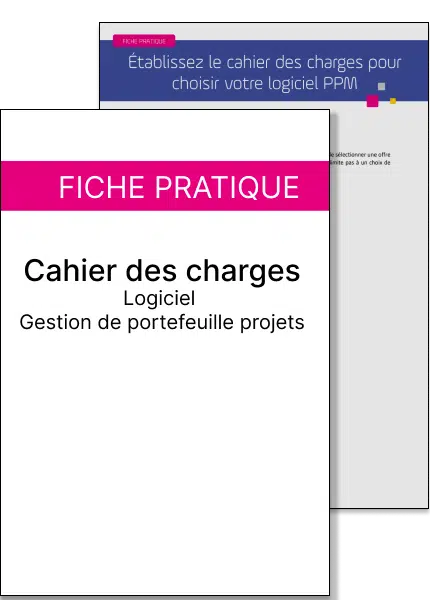Implementing project portfolio management software: benefits, costs, ROI
How can we talk about projects today without talking about Project Portfolio Management (PPM)? To implement "real" project portfolio management, you need to have the right tools. You'll quickly be overwhelmed by the limited functions offered by Excel. Have you considered implementing project portfolio management software within your organization? What are the benefits, challenges and returns on investment of project portfolio management software? Project portfolio management (PPM) is the discipline of dealing with projects from a global point of view, with a view to selection and arbitration. PPM aims to "do the right projects" , while project management focuses on doing projects right. Both are essential to a company's success. Having clarified this point, let's move on to the Return On Investment( ROI) of this approach, and the challenges facing an organization in "doing PPM right".
The benefits of a project portfolio management tool
- A more strategic choice of projects to launch
- Better project success rates
- More transparency
- Risks are better managed
- Resources are used more efficiently
- A common methodology for teams
- Saves time (real-time automation of information + administrative management support (monitoring employee workloads, tracking hours to be billed and managing change requests).
Ebook to download - Calculate the benefits of a PPM solution
PMO, Project Manager, Project Management Consultant: estimate the return on investment of project portfolio management! In this guide: interviews with case studies, key benefits, project sizing keys (costs and deployment)

How do you build up a project portfolio?
Building a project portfolio involves several key steps. Identify potential projects in line with your organization's strategic objectives. Assess their relevance, feasibility and alignment with the overall vision. In this article, you'll find tips for building your project portfolio.
What are the project portfolio performance indicators?
These indicators may vary according to the organization's specific objectives and priorities, but some commonly used ones include return on investment (ROI), on-time delivery, budget compliance, stakeholder satisfaction, quality of deliverables, resource productivity and risk reduction. See this article for examples ofproject portfolio performance indicators.
The benefits of project portfolio software, which generate this ROI, come from a number of different angles
Making better use of resources (especially those that are scarce and critical)
Certain resources are absolutely critical to the success of each and every one of your projects. Unfortunately, as your pool of experts is not unlimited, you run the risk of having to allocate these critical skills to multiple projects that require them. So it's crucial in your prioritization and project launch decisions to have clearly identified which critical resources will be needed for this new project, and to ensure their availability. There's no point in choosing your projects carefully, only to find out later that you don't know how to provide them with the resources they need... PPM provides this visibility on the allocation of resources between projects, enabling you to identify certain scarce or critical resources and keep a close eye on their allocation and proper use.
Increase team and individual productivity
Regardless of who's on the team, it's good to have visibility over all projects and the people allocated to them. Firstly, because it enables all project managers to see when certain skills might be available for their projects. Secondly, because it gives everyone a clearer picture of upcoming projects, enabling them to position themselves and apply for positions on these project teams.
Improve project quality and risk analysis
Of course, one of the biggest project risks is not having the right resources available at the right time. PPM provides better visibility on the progress of various projects, and enables project managers to detect in advance whether certain resources might be stuck on other projects for longer than expected. This will enable them to anticipate and possibly prevent bottlenecks by seeking out other resources or fighting to ensure that those scheduled are released on time. On the other hand, cross-functional visibility of risks encountered on other projects, and of the effectiveness of risk mitigation plans, means that they can be better anticipated on other projects. Similarly, quality problems detected during previous deliveries, and the lessons learned in these situations, will help all projects in the portfolio to deliver better products.
Acquire and share better visibility of internal project progress and activity (for the customer).
We have seen that this visibility is critical internally to better understand and anticipate potential impacts on portfolio projects. This visibility is just as important for customers, who prefer to know as soon as possible whether certain promises on our part could be at risk in terms of deadlines, or on the contrary, possibly available in advance. On the customer side, this information is crucial to the successful implementation and activation of delivered products within their organization.
Reduce external labor costs through better use of internal resources
Knowing as early as possible that critical internal resources are not going to be available as initially planned means that workarounds can be sought. Recruiting external experts is a cost-effective way of acquiring them. Conversely, if the project manager has planned to recruit externally for certain tasks and internal employees with the right skills become available because a project is cancelled or postponed, he can cancel these external expenses and keep the internals fully occupied.
Make better-informed decisions about which projects to launch and which to abandon
Of course, even without PPM, executive management could know when to start or stop certain projects thanks to the progress reports provided by the managers of each of the company's projects. But as soon as the organization manages more than a dozen projects in parallel, the intellectual effort required of all the company's leaders becomes enormous and disproportionate to the rest of their work. The PPM will synthesize all projects and provide views by program, by division, by business objective, by corporate priority... The PPM can't make business decisions for leaders, but it limits their efforts to keep abreast of the progress of all projects, and can provide recommendations informed by factual data.
Eliminate redundant or contradictory systems and applications
In my experience, it's not uncommon for two business units or divisions to launch projects which, without being totally identical, will have a large number of similar functionalities. Developing them several times over would be an enormous waste. It also happens that projects seek to meet the same business objective in completely opposite ways, for example by replacing an old application on the one hand, and seeking to improve the existing one on the other.
Define your project portfolio management needs and challenges to ensure PPM software profitability
Orchestrating the implementation of project portfolio management software
From launch to implementation, you'll need to take several steps to make the right decision. Ensure that your project portfolio software is set up according to your needs and challenges :
- Drawing up specifications for your requirements (expected functionalities, employees and departments concerned, etc.)
- The budget
- Deployment (integration, user training, etc.)
- The project governance that will be set up around this tool (the tool won't live on its own!)
Download the PPM specifications sheet
Have you thought of everything you need to know to choose the right project portfolio management software? This will be a prerequisite for a good return on investment!
Download our useful list of must-haves.
Specifications are an important step in ensuring that the PPM tool you choose meets your needs.

Define the main features of the PPM software you wish to implement in your organization
- Selecting projects to launch
- Resource capacity management
- Budget management
- Project tracking, interdependencies between milestones & phases
- Schedule management
- Risk analysis
- Project portfolio review
💡 Note that deployment can take place in several stages. Prioritize the basic functionalities for your organization (e.g. resource management and project portfolio review) and then implement the other functionalities for more advanced monitoring (e.g. an interface between budget monitoring and your financial erp).
What are the main risks you will undoubtedly encounter and face?
Incomplete or partial attainment of certain objectives, resulting in a reduction in the associated benefits.
Of course, you'll want to be ambitious in your PPM implementation project, and that's very commendable. Thanks to your hard work and the mobilization of your management and project managers, you'll manage to achieve a large number of them. Perhaps you'll even do better than you dared hope. But have no doubt that you'll miss many of them. The work is complex. There are many technical and, above all, cultural parameters.
Additional project costs, requiring unforeseen additional investments
Whatever the initial situation, you're bound to discover unforeseen risks and opportunities along the way in this project to set up a Project Portfolio. It's normal - it's a project like any other, with its own risks and opportunities. So, like any other project, plan a contingency or reserve budget to give you room to maneuver.
Delays in the project, and therefore in the production of deliverables, delay the generation and collection of expected benefits.
Change always takes time, especially when the roles and responsibilities of certain high-ranking people are impacted. So, stay conservative on two points: the amount of benefits achievable as seen above, and the timescales for delivering these benefits.
3 tips for successful implementation of your project portfolio management software
- Design a simple and efficient PPM organization: a single central PMO with very clear and simple decision-making bodies.
- Industrialize processes through the pragmatic deployment of software solutions: request management, project portfolio management, budget management, project management...
- Manage the steering system in a way that evolves and adapts to the company's needs.
Discover the key features of project portfolio management software
What better way to visualize what a PPM tool can do for you? Our consultants can show you in only 30 minutes an overview of the main functionalities that will be useful to manage your project portfolio.
What is the return on investment for project portfolio management software?
The return on investment (ROI) of project portfolio management software is a fundamental calculation for determining the profitability of software implementation. You can always put the cost of the software in front of the benefits. But over and above the tangible benefits in terms of project completion, the time saved and data reliability provided by the use of project portfolio management software are the major arguments in favor of profitability.
What are the benefits of project portfolio management software? Here, for example, is some concrete feedback from our customers using PPM software Project Monitor:
- Würth has reduced its project review times by a factor of 3
- Haute-Savoie department saves one day a week on project management control
- ITM LAI (Intermarché group) has reduced the overall duration of its logistics programs and projects by 30%.
- Chronopost's DIPSI only launches (relevant) projects that it is capable of carrying out.
To find out more and benefit from case studies on the implementation of a PPM tool, browse our case studies